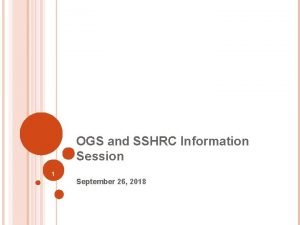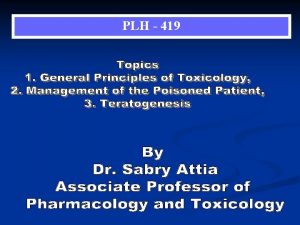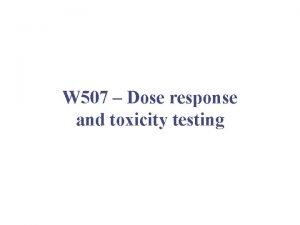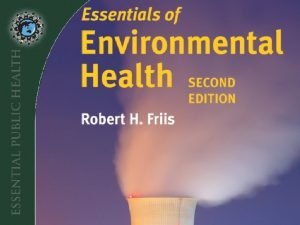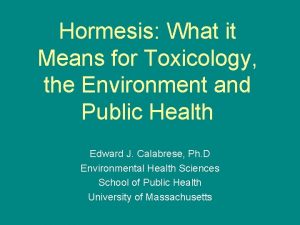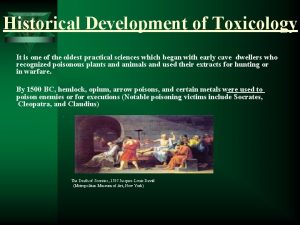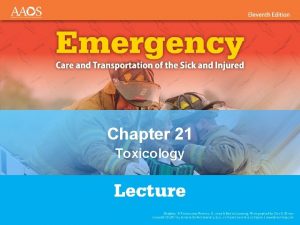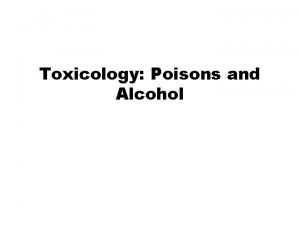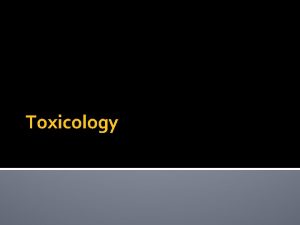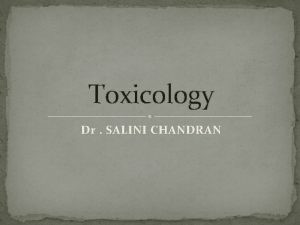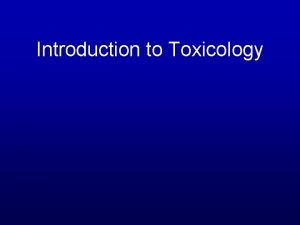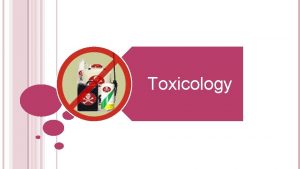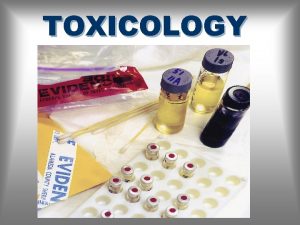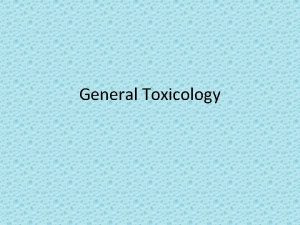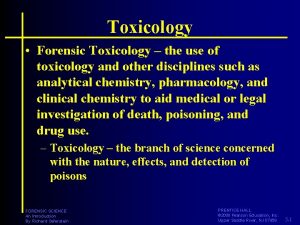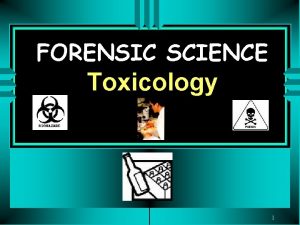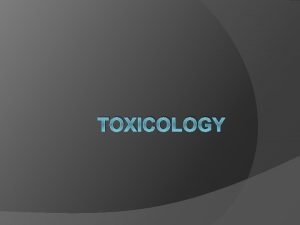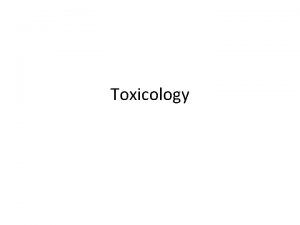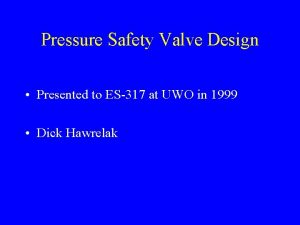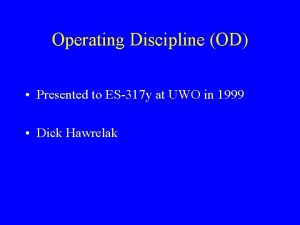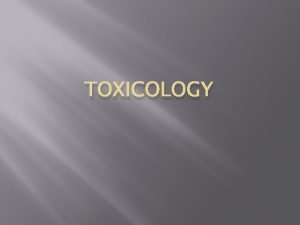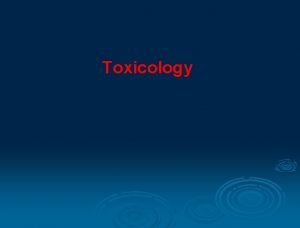Toxicology Presented to ES317 y at UWO in





![Local Irritantia • LC 50(h, 30) = [3. 3/10][LC 50(r, 30) (for rats). • Local Irritantia • LC 50(h, 30) = [3. 3/10][LC 50(r, 30) (for rats). •](https://slidetodoc.com/presentation_image_h2/5e2ab44f3770712ff6c10f4eb71071e4/image-6.jpg)
![Systematically Acting Agents • LC 50(h, 30) = [5. 1/20][LC 50(r, 30) • A Systematically Acting Agents • LC 50(h, 30) = [5. 1/20][LC 50(r, 30) • A](https://slidetodoc.com/presentation_image_h2/5e2ab44f3770712ff6c10f4eb71071e4/image-7.jpg)













- Slides: 20

Toxicology • Presented to ES-317 y at UWO in 1999 • Dick Hawrelak

Consequences to Humans • Consequences of toxic chemical exposure are usually derived from animal experiments (rats, mice, dogs, etc. ). • Search the internet for “Holocaust” for the exception to this statement.

Uncertainties in Animal Data • The uncertainties in translating small animal data to data relevant for humans are large and therefore safety factors are included in the modeling.

Acute Versus Chronic Injury • Emergency planners generally deal with acute or short term lethal injury (2000 people died in a few days in Bhopal toxic release). • Environmentalists deal with longer term chronic injury (eg cancer after 20 years of exposure).

Two Acute Categories • Local Irritantia (LI) deals with direct damage to the lungs. • Sytematically Acting Agents (SAA) deals with damage to the body via the blood and distribution in the body.
![Local Irritantia LC 50h 30 3 310LC 50r 30 for rats Local Irritantia • LC 50(h, 30) = [3. 3/10][LC 50(r, 30) (for rats). •](https://slidetodoc.com/presentation_image_h2/5e2ab44f3770712ff6c10f4eb71071e4/image-6.jpg)
Local Irritantia • LC 50(h, 30) = [3. 3/10][LC 50(r, 30) (for rats). • Animals have a higher adsorption rate, safety factor set at 5 • Humans have a higher respiratory rate in accident situations, safety factor set at 2 • Hence, a safety factor of 10 is used in LI.
![Systematically Acting Agents LC 50h 30 5 120LC 50r 30 A Systematically Acting Agents • LC 50(h, 30) = [5. 1/20][LC 50(r, 30) • A](https://slidetodoc.com/presentation_image_h2/5e2ab44f3770712ff6c10f4eb71071e4/image-7.jpg)
Systematically Acting Agents • LC 50(h, 30) = [5. 1/20][LC 50(r, 30) • A large uncertainty factor of 10 is introduced for blood effects. • Humans have a higher respiratory rate in accident situations, safety factor set at 2. • Hence a safety factor of 20 is used in SAA.

Convert Animal Data to Humans • Once experimental data is available, a standard regression line is drawn through all the converted data (Animals to Humans). • The data is plotted as LN(time) as the x-axis and LN(Conc) as the y-axis.

H 2 S Data

Standard Deviations About the Regression Line. • One standard deviation covers 67% of the data points. • Two standard deviations covers 95% of the data points. • The regression line is assigned LC 50. • The mean + 2 SD is assigned LC 99. • The mean - 2 SD is assigned LC 01.

Probits • The data between LC 99 and LC 01 can be converted to regular standard intervals by the use of a probit equation. • Pr = a + b Ln[(C^n)(t)] • n = 1 / m where m is the slope of the regression curve. Ln is the Natural Log. • a and b are constants to suit the intermediate LC values.

Probit Chart For H 2 S

Two Databases for Toxic Chemicals • The UK database as in CPQRA of the CCPS / AICh. E. • The Dutch database as in Prince Maritus lab (Green Book by TNO). • The two databases give different answers for acute injury rates. • The differences remain unresolved and are being debated in academia.

The Holocaust Data for HCN • CPQRA gives a fatal dose at 5 minutes for 2, 000 ppmv exposure. • TNO gives a fatal dose at 0. 5 minutes for 2, 000 ppmv exposure.

Other Conflicting Data • Industrial hygienists have used STEL, TLV, ERPG 1, ERPG 2 and IDLH for years. • These concentration / time values should mesh smoothly with the acute time / concentration data. • Often adjustment have to be made to have a set of data that is satisfactory to both industrial hygienists and emergency planners.

Probit Program • Toxic consequences can be determined using the Probit Data V 1. 1 program in Chemical Plant Hazards Toxicology Probit Data V 1. 1 files. • The user selects a chemical from the d. B, a probit method, a concentration and an exposure time. • The program determines the consequence as shown on the following example.

Probit Data V 1. 1

Probit Data V 1. 1 Chart

H 2 S Animal Data • As an example of the above procedure, the Concord Scientific Data for H 2 S is presented in Chemical Plant Hazard Toxics Toxicology H 2 S Data file. • This technology is quite complex and is generally offered at the graduate level. • Work is in progress to make this more understandable at the undergraduate level.

Possible Exam Question • Describe acute versus chronic injury. • What two databases are available that describe the toxicity of certain chemicals? • ***
 Michael smith foreign study supplement
Michael smith foreign study supplement Studentcare uwo
Studentcare uwo Ogs uwo
Ogs uwo Uwo webct
Uwo webct Fims uwo
Fims uwo Kathleen hill uwo
Kathleen hill uwo Ssc psychology
Ssc psychology Uwo ethics
Uwo ethics Mme uwo
Mme uwo Drug identification and toxicology
Drug identification and toxicology Toxicology defination
Toxicology defination W 507
W 507 Toxicology definition
Toxicology definition Father of forensic serology
Father of forensic serology Hormesia
Hormesia Examples of toxicology
Examples of toxicology Toxicology management
Toxicology management Dumbels emt
Dumbels emt Toxicology
Toxicology Toxicology effects
Toxicology effects Toxicology and applied pharmacology
Toxicology and applied pharmacology
